-

部编人教版一年级下册识字 《小青蛙》说课稿
一、说教材小青蛙是小学一年级语文下册第一单元识字课中的第三课,这是一首儿歌形式的字族文识字课,读起来朗朗上口,音韵和谐,讲述了小青蛙的外形和本领,号召大家要保护小青蛙。本课共有12个生字,其中母体字“青”和不同的形旁搭配,构成五个新字,形成了以“青”为基础的一组音近、形近的形声字,而这些字的意思在这首儿歌的情景中有具体体现,于是这些字的音形义在语境中便巧妙的联系起来,很有特点。二、说学情低年级孩子由于受年龄特点和认知发展特点的限制,爱玩好动,思维活跃,表现欲强,但持久性差。只有尊重孩子的天性,才能收到理想的学习效果,那么让课堂充满乐趣,不仅是低年级孩子的心理需求,也是语文教学、识字教学本身内在的要求。另外,虽然孩子们已经有半年的语文学习经验,但识字能力尚在形成过程中,教师仍需指导识字方法,让学生跟着老师一起感悟。
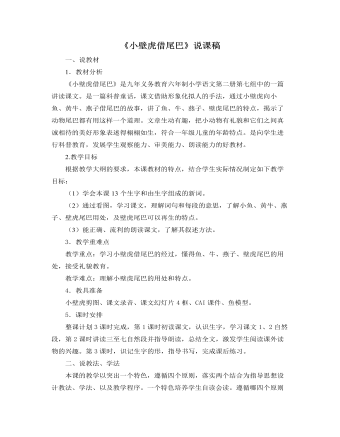
部编人教版一年级下册《小壁虎借尾巴》说课稿
2.教学目标根据教学大纲的要求,本课教材的特点,结合学生实际情况制定如下教学目标:(1)学会本课13个生字和由生字组成的新词。(2)通过看图,学习课文,理解词句和每段的意思,了解小鱼、黄牛、燕子、壁虎尾巴用处,及壁虎尾巴可以再生的特点。(3)能正确、流利的朗读课文,了解其叙述方法。3.教学重难点教学重点:学习小壁虎借尾巴的经过,懂得鱼、牛、燕子、壁虎尾巴的用处,接受礼貌教育。教学难点:理解小壁虎尾巴的用处和特点。4.教具准备小壁虎剪图、课文录音、课文幻灯片4框、CAI课件、鱼模型。5.课时安排整课计划3课时完成,第1课时初读课文,认识生字,学习课文1、2自然段,第2课时讲读三至七自然段并指导朗读,总结全文,激发学生阅读课外读物的兴趣。第3课时,识记生字的形,指导书写,完成课后练习。
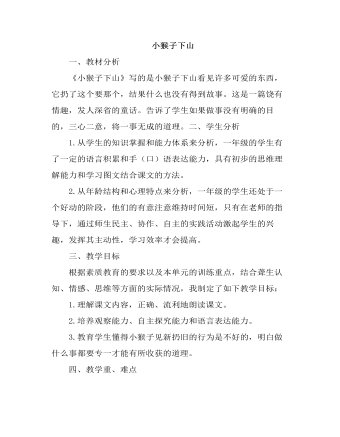
部编人教版一年级下册《小猴子下山》(说课稿)
三、教学目标根据素质教育的要求以及本单元的训练重点,结合聋生认知、情感、思维等方面的实际情况,我制定了如下教学目标:1.理解课文内容,正确、流利地朗读课文。2.培养观察能力、自主探究能力和语言表达能力。3.教育学生懂得小猴子见新扔旧的行为是不好的,明白做什么事都要专一才能有所收获的道理。四、教学重、难点本课的关键是必须处理好形象的图和抽象的文字之间的关系,因为只有图文紧密结合了,才能使学生了解小猴子活动的顺序和事物之间的联系,从而有效的发展学生的语言和思维。五、说教法、学法1.教法结合学生的个体差异和不同的学习需求,依据本课故事性强,画面丰富,结构类似的特点,我主要采取了以下教学方法:(1)图文结合的情景教学法。(2)以扶为主的扶放教学法。(3)读思结合的品读感悟法。
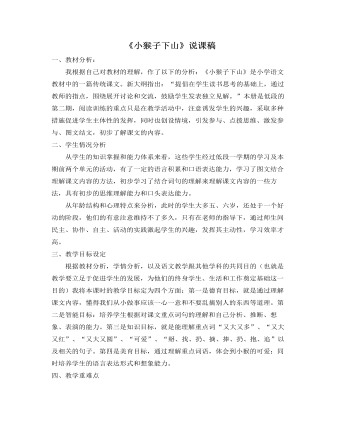
部编人教版一年级下册《小猴子下山》说课稿
二、学生情况分析从学生的知识掌握和能力体系来看,这些学生经过低段一学期的学习及本期前两个单元的活动,有了一定的语言积累和口语表达能力,学习了图文结合理解课文内容的方法,初步学习了结合词句的理解来理解课文内容的一些方法,具有初步的思维理解能力和口头表达能力。从年龄结构和心理特点来分析,此时的学生大多五、六岁,还处于一个好动的阶段,他们的有意注意维持不了多久,只有在老师的指导下,通过师生间民主、协作、自主、活动的实践激起学生的兴趣,发挥其主动性,学习效率才高。三、教学目标设定根据教材分析,学情分析,以及语文教学跟其他学科的共同目的(也就是教学要立足于促进学生的发展,为他们的终身学生、生活和工作奠定基础这一目的)我将本课时的教学目标定为四个方面:第一是德育目标,就是通过理解课文内容,懂得我们从小做事应该一心一意和不要乱摘别人的东西等道理。第二是智能目标:培养学生根据对课文重点词句的理解和自己分析、推断、想象、表演的能力。第三是知识目标,就是能理解重点词“又大又多”、“又大又红”、“又大又圆”、“可爱”、“掰、找、扔、摘、捧、扔、抱、追”以及相关的句子。第四是美育目标,通过理解重点词语,体会到小猴的可爱;同时培养学生的语言表达形式和想象能力。

部编人教版一年级下册识字《小青蛙》(说课稿)
一、说教材《小青蛙》是一篇孩子们喜欢的儿歌。本组教材充分体现了工具性和人文性的统一。本文要求掌握的生字7 个,要求会认的字12个。由于面对的是低年级学生。我尽量把识字和阅读结合起来,以识字为主,阅读为辅,以多种游戏的形式,使枯燥的识字教学”活“起来。二、说教法学法教法:新课标倡导学生是学习和发展的主体,语文教学要关注学生的个体差异和不同的学习需求,爱护学生的好奇心、求知欲,充分激发学生的主动意识和进取精神。因此,将教学方法确定为促进学生自主、合作、探究性学习的“情境教学法”和“自主识字法。”教学中要充分利用多媒体直观教学手段,创设情境,开展活动,有张有弛,引导学生积极主动地投入到学习活动中去。
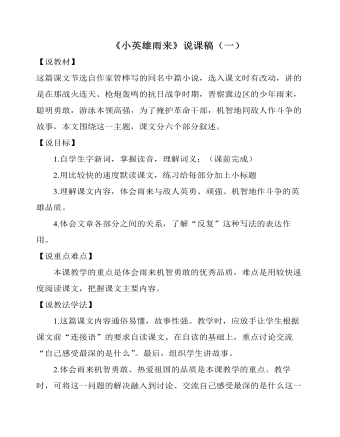
部编人教版四年级下册《小英雄雨来》说课稿(一)
【说教材】这篇课文节选自作家管桦写的同名中篇小说,选入课文时有改动,讲的是在那战火连天、枪炮轰鸣的抗日战争时期,晋察冀边区的少年雨来,聪明勇敢,游泳本领高强,为了掩护革命干部,机智地同敌人作斗争的故事,本文围绕这一主题,课文分六个部分叙述。【说目标】1.自学生字新词,掌握读音,理解词义;(课前完成)2.用比较快的速度默读课文,练习给每部分加上小标题3.理解课文内容,体会雨来与敌人英勇、顽强、机智地作斗争的英雄品质。
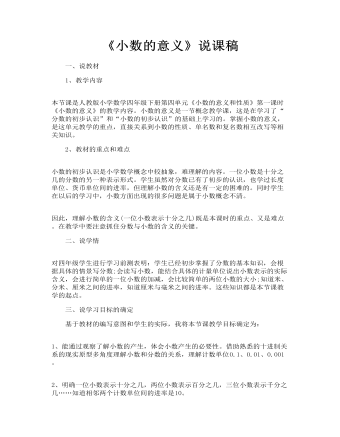
《小数的意义》说课稿
2、教材的重点和难点 小数的初步认识是小学数学概念中较抽象,难理解的内容。一位小数是十分之几的分数的另一种表示形式。学生虽然对分数已有了初步的认识,也学过长度单位、货币单位间的进率,但理解小数的含义还是有一定的困难的。同时学生在以后的学习中,小数方面出现的很多问题是属于小数概念不清。 因此,理解小数的含义(一位小数表示十分之几)既是本课时的重点、又是难点。在教学中要注意抓住分数与小数的含义的关键。 二、说学情 对四年级学生进行学习前测表明:学生已经初步掌握了分数的基本知识,会根据具体的情景写分数;会读写小数,能结合具体的计量单位说出小数表示的实际含义,会进行简单的一位小数的加减,会比较简单的两位小数的大小;知道米、分米、厘米之间的进率,知道厘米与毫米之间的进率。这些知识都是本节课教学的起点。 三、说学习目标的确定 基于教材的编写意图和学生的实际,我将本节课教学目标确定为: 1、能通过观察了解小数的产生,体会小数产生的必要性。借助熟悉的十进制关系的现实原型多角度理解小数和分数的关系,理解计数单位0.1、0.01、0.001。

小班数学教案:花儿朵朵(3以内数量)
2、在观察图片和提问的引导下,探索用点卡表示实物的数量。 3、喜爱参加数学活动,体验活动的乐趣。 活动准备: 1、教具——花的图片6张,其中数量为1、2、3的花朵两张; ——1、2、3、的点卡片各一张,分类和底板。 2、学具——操作材料人手一套实物和点卡操作图片,分类盒人手一个。 活动过程: 一、 感知图片数量,认识点子标记。 1、师:小朋友看这儿有什么?每张图片上有几朵花?我们一起来数一数好吗?

幼儿园小班数学教案 数量对应1-5
【活动过程】一、感官游戏:手指谣:《猴子荡秋千》 5只猴子荡秋千,嘲笑鳄鱼被水淹,鳄鱼来了,鳄鱼来了,go go go 4只猴子荡秋千,嘲笑鳄鱼被水淹,鳄鱼来了,鳄鱼来了,go go go 3只猴子荡秋千,嘲笑鳄鱼被水淹,鳄鱼来了,鳄鱼来了,go go go 2只猴子荡秋千,嘲笑鳄鱼被水淹,鳄鱼来了,鳄鱼来了,go go go 1只猴子荡秋千,嘲笑鳄鱼被水淹,鳄鱼来了,鳄鱼来了,go go go 二、数学心智: 1、轻音乐,取插板。 2、森林里有一棵大树。(取出一棵树插在演示板上,幼儿插在插板上。)问小朋友几棵树啊?(1棵)取出数字1 3、大树结了两个苹果,熟透了,落下了,请小朋友取出两个苹果放在树下。问:落下来几个苹果?(2个)取出数字2

新人教版高中英语必修3Unit 1 Festivals and Celebrations-Reading for writing教学设计二
Step 3 Analyzing article structureActivity 31. Teachers raise questions to guide students to analyze the chapter structure of this diary and think about how to describe the festival experience. (1)What should be included in the opening/body/closing paragraph(s)?(2)How did the writer arrange his/her ideas?(3)What kind of interesting details did the writer describe?(4)How did the writer describe his/her feelings/emotions during the event?2. Students read and compare the three sentence patterns in activity 2. Try to rewrite the first paragraph of the diary with these three sentence patterns. After that, students exchange corrections with their partners. Such as:●This was my first time spending three days experiencing the Naadam Festival in China’s Inner Mongolia Autonomous Region and it was an enjoyable and exciting experience. ●I'll never forget my experience at the Naadam Festival because it was my first time to watch the exciting Mongolian games of horse racing, wrestling, and archery so closely. ●I'll always remember my first experience at the Naadam Festival in China’s Inner Mongolia Autonomous Region because it was so amazing to spend three days witnessing a grand Mongolian ceremony. Step 4 Accumulation of statementsActivity 41. Ask the students to read the diary again. Look for sentences that express feelings and emotions, especially those with the -ing form and the past participle. Such as:● …horse racing, wrestling, and archery, which are all so exciting to watch. ● some amazing performances● I was surprised to see…● I was a little worried about. . . ● feeling really tiredOther emotional statements:●I absolutely enjoyed the archery, too, but the horse races were my favourite part. ●I'm finally back home now, feeling really tired, but celebrating Naadam with my friend was totally worth it. ●He invited me back for the winter to stay in a traditional Mongolian tent and cat hot pot. I can’t wait!2. In addition to the use of the -ing form and the past participle, the teacher should guide the students in the appreciation of these statements, ask them to memorize them, and encourage them to use them reasonably in writing practice.

新人教版高中英语必修3Unit 4 Space Exploration-Listening&Speaking&Talking教学设计二
The themes of this part are “Talk about how to become an astronaut” and “Talk about life in space”. As Neil Armstrong said “Mystery creates wonder and wonder is the basis of man’s desire to understand. Space is difficult for human to reach, therefore, humans are full of wonders about it. However, if wanting to achieve the dream of reaching the Moon, some of our human should work hard to be an astronaut at first. Part A(Talk about how to become an astronaut) is a radio interview in a radio studio, where the host asked the Chinese astronauts about his story how to become an astronaut. Yang Liwei told his dreamed to be an astronaut since childhood. Then he worked hard to get into college at 22. The next 10 years, he gradually became an experienced pilot. At the same time, to be an astronaut, he had to study hard English, science and astronomy and trained hard to keep in good physical and mental health and to practise using space equipment. Part B (Talk about life in space) is also an interview with the astronaut Brown, who is back on the earth. The host Max asked about his space life, such as his emotion about going back the earth, the eating, shower, brushing, hobbies and his work. Part A and Part B are interviews. So expressing curiosity about the guests’ past life is a communicative skill, which students should be guided to learn.1. Students can get detailed information about how Yang Liwei became an astronaut and Max’s space life.2. Students learn to proper listening strategy to get detailed information---listening for numbers and taking notes.3. Students can learn related sentences or phrases to express their curiosity like “ I wish to know...” “I’d love to know...”4. Students can learn more about the space and astronauts, even be interested in working hard to be an astronaut
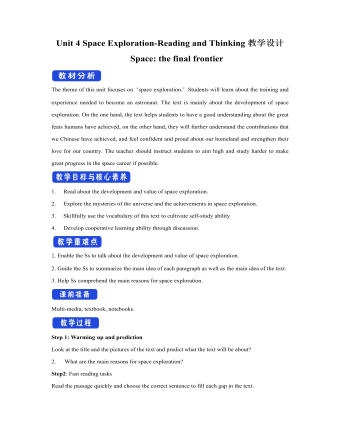
新人教版高中英语必修3Unit 4 Space Exploration-Reading and Thinking教学设计二
The theme of this unit focuses on “space exploration.” Students will learn about the training and experience needed to become an astronaut. The text is mainly about the development of space exploration. On the one hand, the text helps students to have a good understanding about the great feats humans have achieved, on the other hand, they will further understand the contributions that we Chinese have achieved, and feel confident and proud about our homeland and strengthen their love for our country. The teacher should instruct students to aim high and study harder to make great progress in the space career if possible.1. Read about the development and value of space exploration.2. Explore the mysteries of the universe and the achievements in space exploration.3. Skillfully use the vocabulary of this text to cultivate self-study ability 4. Develop cooperative learning ability through discussion.1. Enable the Ss to talk about the development and value of space exploration.2. Guide the Ss to summarize the main idea of each paragraph as well as the main idea of the text.3. Help Ss comprehend the main reasons for space exploration. Multi-media, textbook, notebooks.Step 1: Warming up and predictionLook at the title and the pictures of the text and predict what the text will be about?2. What are the main reasons for space exploration?
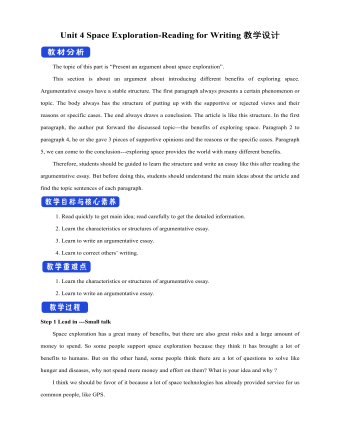
新人教版高中英语必修3Unit 4 Space Exploration-Reading for Writing教学设计二
⑦在我看来, 探索太空是值得的。As far as I am concerned, it is worthwhile to explore the space.Step 10 Writing---draftRecently, students in our class have had heated a discussion on whether space is worth exploring. Students hold different ideas about it.30% of us think space exploration is not worthwhile. They think space is too far away from us and our daily life and is a waste of money. And the money spent on space exploration can be used to solve the earth’s problems such as starvation and pollution.On the other hand,70% think space is worth exploring because we have benefited a lot from it,such as using satellites for communication and weather forecast. What’s more,with further space research,we may solve the population problem by moving to other planets one day. Also,space research will enable us to find new sources to solve the problem of energy shortages on the earth.As far as I am concerned, it is worthwhile to explore the space. Not only can it promote the development of society but also enrich our life. Step 11 Pair workExchange drafts with a partner. Use this checklist to help your partner revise his/her draft.1.Does the writer explain why he/she changed/wanted to change?2.Does the writer tell how the changes have improved or will improve his/her life?3.Is the text well-organised?4.Does the writer use words and expressions to show similarities and differences?5.Are there any grammar or spelling errors?6.Does the writer use correct punctuation?
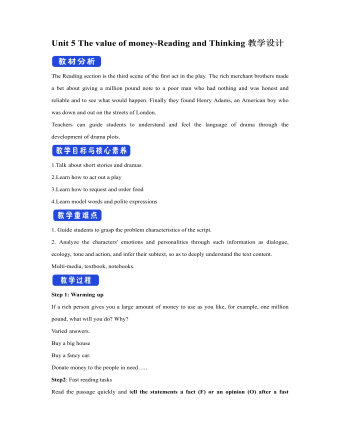
新人教版高中英语必修3Unit 5 The value of money-Reading and Thinking教学设计二
? Could you offer me some kind of work here?? I don’t want your charity, I just want an honest job.? Careless: I landed in Britain by accident.Step 7:Consolidation.? Find Henry? Roderick and Oliver were I .making a bet when they saw Henry, a poor young man. ? Know Henry? About a month ago, Henry was sailing and later he found himself carried out to sea by a strong wind. Fortunately, he 2.was spotted by a ship. And it was the ship that brought him to 3.England? Offer money to Henry ? Oliver and Roderick gave Henry a letter and told him that there was money in it. They 4.persuaded him to accept it, and made him 5.promise that it wouldn't be opened until 2 o'clock.Step 8:Language pointsa large amount of: a large quantity of; a great deal ofe.g. They bought a large amount of furniture before they moved their new house.make a bet: make an arrangement to risk money, etc. on an event of which the result is doubtful.e.g. We made a bet on the result of the match.permit sb to do something: allow somebody to do somethinge.g. My mother doesn’t permit me to ride in the street after it rained.by accident: as a result of chancee.g. I only found it by accident.stare at: look at somebody or something with the eyes wide open in a fixed gaze( in astonishment, wonder, fear, etc)to be honest: to tell you the truth; to be franke.g. To be honest, I don’t think we have a chance of winning.Step7 Homework:What do you think will happen to Henry? Will the bank-note help him or get him into trouble?

新人教版高中英语必修3Unit 5 The Value of Money-Reading for Writing教学设计二
2. 您能看到, 我头发太长了。You can see that my hair is much too long.3. 无论什么时候, 只要您想回来就回来。Please come back whenever you want.4. 您仅有很少的头发要理! You only have too little hair to cut !5. 为您服务是我的荣幸!It is my honour to serve you!Step 9 Writing(Henry is walking down the street when he sees a sign for a place that cuts hair. He decides to have it cut. )H=Henry B=BarberH: Good afternoon, I’d like to have my hair cut, if I may. (The barber looks at Henry’s hair and continues cutting another man’s hair. ) Er, I’d really like a haircut. As you can see it’s much too long. B: (in a rude manner) Yes, I can see that. Indeed, I can. H: Fine, well, I’ll have a seat then. (He sits in one of the barber’s chairs. The barber turns to look at Henry. )B: It’s quite expensive here, you know! Are you sure you can afford it?H: Yes. I think so. (After his hair is cut, the barber tells Henry how much he must pay. Henry shows the barber the bank note. )B: Why Mr. . . (looks shocked)H: Adams. Henry Adams. I’m sorry. I don’t have any change. B: Please don’t worry! (wearing a big smile) Nothing to worry about! Nothing at all! Please come back whenever you want, even if you only have too little hair to cut! It will be my honour to serve you!Step 10 Pair workExchange drafts with a partner. Use this checklist to help your partner revise his/her draft.1. Are all the elements of a play included and in good order ?2. Do the character use suitable language ?3. Are the stage directions clear and useful ?4. Is the plot clear and exciting enough ?
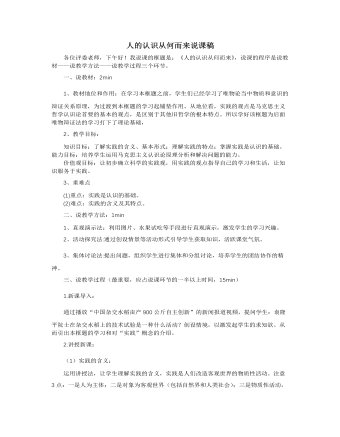
人教版高中政治必修4人的认识从何而来说课稿(一)
展示学习过的物理学内容:伽利略的“比萨斜塔”实验,证明了:两个铁球同时落地。得出结论:实践是检验认识正确与否的唯一标准。(因为这点理解起来有点难,所一教师要适当的讲解)A、一种认识是否是真理不能由这一认识本身回答B、客观事物自身也不能回答认识是否正确地反映了它C、实践是联系主观与客观的桥梁。人们把认识和实践的结果对照,相符合,认识就正确。○4实践是认识的目的和归宿:走进社会:(课本P46归国博士案例)从这个故事中我们可以得到什么启示?得出结论:实践是认识的归宿和目的。启发学生学以致用,eg:纪中的学生研究地沟油简易检测方法(灵活利用身边的教学资源)。【板书设计】实践是认识的基础(板书)投影:逐步展示本课知识结构图。学生通过回忆,让学生有直观的认识,学习内容一目了然。1.实践是认识的来源。2.实践是认识发展的动力。3.实践是检验认识的真理性的唯一标准。
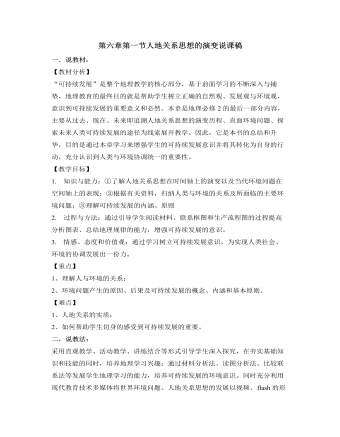
人教版高中地理必修2第六章第一节人地关系思想的演变说课稿
四、说教学过程:1、导入新课:以视频形式导入新课,说明环境问题产生原因,引出人地关系的重要性2、新课讲授:学习主题一:过去——人地关系的历史回顾以动画形式展现人地关系思想的发展,激发学生学习本专题的兴趣,归纳人与自然关系的演变过程。学习主题二:现状——直面环境问题以人类与环境关系模式图说明环境问题产生的原因,人地关系实质;以因果联系框图培养学生判读方法,了解人口、资源与环境三者之间的关系;通过阅读课文,了解环境问题的类型及其空间差异的表现;以图表了解不同国家和地区环境问题在空间轴上的表现;以《京都议定书》为引子说明保护环境是全人类的共同使命学习主题三:未来——可持续发展展示“可持续发展示意图”理解可持续发展内涵、原则

人教版高中地理必修2第一章第三节人口的合理容量说课稿
【教学目标】知识与技能:理解环境承载力与环境人口容量的含义、两者的关系以及环境人口容量的影响因素;理解人口合理容量的含义,影响因素并掌握保持人口合理容量的做法;结合中国国情提出适合中国保持合理人口容量的措施过程与方法:通过问题探究及案例分析理解环境承载力与环境人口容量的关系及影响因素;通过问题探讨掌握保持人口合理容量的措施。情感态度与价值观:树立并强化学生的可持续发展观念,科学发展观。激发学生爱国情感更多地关注国家国情,树立主人翁意识保护地球强大祖国。【教学重点】环境人口容量的内涵以及影响因素人口合理容量的影响因素以及措施【教学难点】环境人口容量的内涵以及影响因素人口合理容量的影响因素以及措施二、说教法【教学方法】案例分析、问题探究、归纳总结
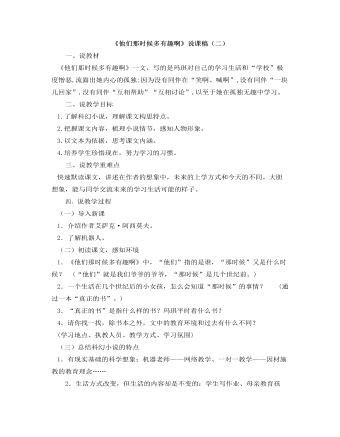
部编人教版六年级下册《他们那时候多有趣啊》说课稿(二)
一、说教材《他们那时候多有趣啊》一文,写的是玛琪对自己的学习生活和“学校”极度憎恶,流露出她内心的孤独;因为没有同伴在“笑啊、喊啊”,没有同伴“一块儿回家”,没有同伴“互相帮助”“互相讨论”,以至于她在孤独无趣中学习。 二、说教学目标1.了解科幻小说,理解课文构思特点。2.把握课文内容,梳理小说情节,感知人物形象。3.以文本为依据,思考课文内涵。4.培养学生珍惜现在,努力学习的习惯。 三、说教学重难点快速默读课文,讲述在作者的想象中,未来的上学方式和今天的不同。大胆想象,能与同学交流未来的学习生活可能的样子。 四、说教学过程(一)导入新课1.介绍作者艾萨克·阿西莫夫。2.了解机器人。(二)初读课文,感知环境1.《他们那时候多有趣啊》中,“他们”指的是谁,“那时候”又是什么时候? (“他们”就是我们爷爷的爷爷,“那时候”是几个世纪前。)
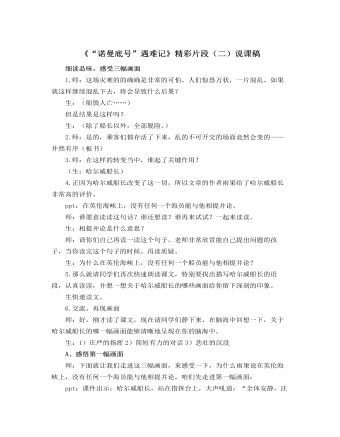
部编人教版四年级下册《 “诺曼底号”遇难记》精彩片段(二)说课稿
师:对,镇定自若。(板书:镇定自若)这份镇定自若,别人能与他相提并论吗?(不能)4.你还能从这段话中读出什么来?妇女先走,船员断后。咱们常说女士优先,在灾难面前也做到让妇女先走,这叫什么?生:绅士风度。(板书:绅士风度)5.同学们,假如你就是哈尔威船长,面对混乱的人群,你准备怎样来下达这道命令?指名学生朗读。(师指导:场面混乱,情况危急。)师:在灾难面前,时间就是生命。师:这是庄严的指挥,这是威严的指挥。我们一起来读读。师:真好,读得好,脸部的表情也非常到位,满脸的威严,正因为这样,所以课文的作者雨果是这样评价船长的,再读。ppt:在英伦海峡上,没有任何一个海员能与他相提并论。(生齐读)师:不能与他相提并论的还有他的:忠于职守、镇定自若、绅士风度。这是咱们从第一幅画面中感受到的。

